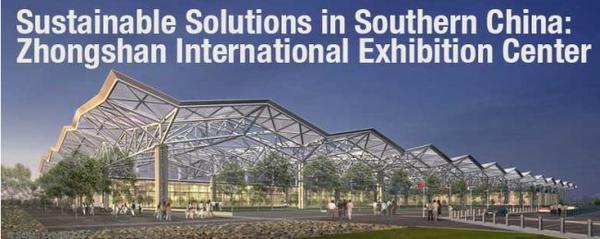
The megastructure
Zhongshan (named after Dr. Sun Zhongshan, who is also known as Sun Yat-sen), a prefecture-level city in the south of the Pearl River Delta in Guangdong province city of Southern China (close to Hong Kong), is long known to be a city of parks, boulevards and various monuments. And now with the spate of recent investments, the city is certainly looking forth to step into an era of unprecedented economic advancement. Statistical figures say that the total GDP output of the city has grown more than a whopping 187 times, since 1980. And in this propitious time, Zhongshan is all set to accentuate upon its sustainable quotient, with its all new and ‘green’ Zhongshan International Exhibition Center designed by SOM Architects.
What makes it mega?
Exhibition centers have been the part and parcel of many in a major city, especially since those industrial trade fairs being held in 19th century. But in this case, the Zhongshan International Exhibition Center certainly encompasses much more than the spatial characteristic of a conventional exhibition center. Basically alluding to a large central community center, SOM has decisively designed a structure with a plethora of spatial elements including exhibition and meeting spaces, large lobbies, flexible dining areas, offices, a central plant, building support areas, and even a grand plaza for civic events. All of these elements and courtyards are sheltered under one large sculptural roof system.
Moreover, the design considerations are taken in such a way so as to infuse the convenient virtue of flexibility in functionality as well as usage.
Coming to the overall form and facade, the design pursues a dynamic pattern, especially in relation to the detailed sculptured roof (which by the way is also photovoltaic) consisting of highly efficient trusses. The exterior facade displays the ubiquitous zig-zag pattern with an artistically abstract touch. There are also deep symbolic elements that can be associated with the design. For example, the faceted panels represent the rolling hills of Zhongshan, whereas during the night time, the interior lighting traversing through the glass panels will give us the ambiance of traditional Chinese lanterns.
Eco credentials
From the beginning of the design process, it was already determined that the mega project would stick to the stringent self sustainable norms for which SOM is known. So the whole structure pertains to sustainability by incorporating a five point procedure including – energy-efficient layouts, high-performance building control systems, natural heating and cooling, and making use of clean solar power.
In contrast to high energy usage in Zhongshan (from fossil fuels), the structure’s design was subject to some major alterations since its inception; and all of this was surprisingly related to the mode of clean energy source that was to be used. First, an ambitious design process was envisaged in which more than 2,500 wind turbines were fixed on the roof section. But after initial testing, the energy production results were not up to the mark. So a continuous photovoltaic system was incorporated on the roof, with 800 solar collectors replacing the 2,500 wind turbines for enhanced production of clean energy. Moreover, the roof dually acts as the state-of-the-art shading system by featuring UV coated skylights for natural lighting and ventilation. And at last but not the least, coming to the basement level, the mega yet low emission exhibition center will also feature natural lighting and geo-thermal heat sinks, for naturally controlling the temperature at ground level.




